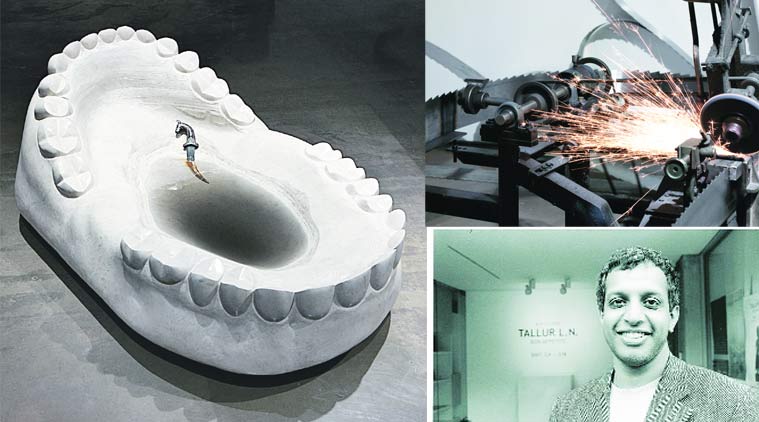Future is Present
Artist LN Tallur, whose latest exhibition is on in Seoul currently, talks about the concerns that shape his art, and being on the move constantly.
 LN Tallur’s 2014 work Tongue Twisters; the artist; his 2015 work The Threshold
LN Tallur’s 2014 work Tongue Twisters; the artist; his 2015 work The Threshold
Traditional symbols engage with contemporary concerns in LN Tallur’s works. His latest exhibition “Threshold”, which is on in Seoul (South Korea), is no different. Here, the 44-year-old has centred his oeuvre on varied concerns and practices, covering a range of topics — from the halal slaughter to colonial India. In the middle of designing a public sculpture, to be installed in Manipal, and a New York solo scheduled next year, the 2012 SKODA Prize winner talks about being on the move, personally and professionally.
In your works, you often play on the ironies. “Threshold”, for instance, demonstrates how one consumes present time to prepare for the future. Could you talk about this engagement?
I’ll explain this through money matter, which we can easily understand. I designed a money-polishing machine (Apocalypse, 2010). If you put a coin inside this machine, it will polish the coin to shine. Naturally, you want more sheen and would like to polish more, but if you keep polishing, the denomination on the coin disappears; it becomes a piece of metal. We always equalise being well-mannered to being polished. Something similar happens in Eraser pro — as time passes, great ideas get erased. An Irish novelist sums up our condition: “When you don’t have any money, the problem is food. When you have money, it’s sex. When you have both, it’s health. If everything is simply Jake, then you’re afraid of death.”
You often borrow from tradition and mythology with regard to form and ideas.
If we start from known signals, it is comfortable to travel and jump into complex areas. Past experiences influence current practices. When I was studying museology (at the University of Baroda), I was exposed to several museum objects. I studied them through their historical angle, and history is not just a mirror for our past, it is also a mirror for our present and future. Museums try to conceptualise objects to present the current needs of a country. I, too, see these objects in the contemporary context.
How was it to directly engage with objects at Mumbai’s Bhau Daji Lad Museum for “Quintessential” (2011)?
It is always a challenge to juxtapose works of art with historical facts; even a small shift can turn your work of art into a pamphlet, a propaganda material. It was thrilling to work with real museum objects. One of the exhibits was based on the stone elephant in front of the museum. Originally at the Elephanta caves, in 1864, the British attempted to transport this piece to England but the crane crashed and the elephant was shattered into pieces. It was reinstalled here. In response to this, I made a wooden elephant, cut it into pieces and created a 3D puzzle game. The challenge in the puzzle is to recreate the elephant with broken pieces by looking at the live video of the original elephant. I want this piece to be shown in England to fulfill the dream of the British.
There is often an interactive element in your art. For instance, in Chromatophobia: The Fear of Money, you invited audience to nail coins into a wood log. And in Do or Die, you asked them to move the sculpture by using the steel rod jutting out of its body.
I have always believed in a multi-sensory approach in my works. When all the five senses are at work, that deepens the experience. Working out this is a big challenge for an artist, but conceptualising the act of interaction is very important. I’ve also been influenced by science museums, where gadgets or interactive methods are used to explain complex theories.
You also employ traditional craftsmen for your sculptures. Could you talk a bit about this collaboration?
When I was teaching at an art school, immediately after completing my post-graduation at Leeds, I had to guide 15 differently thinking students. I had to get into their head and guide them their way. This experience fascinated me and I started collaborating with others. I believe many craft forms, especially Indian crafts, are very matured but saturated. I attempt to work with different crafts and conceptualise them the way I want it. For instance, for Colonial Sisters (2008), I worked with two carvers in Karnataka. One does classical sandalwood carvings and another is a neo-carver. I asked them to sculpt a standing mother and child. The only restriction was size. I brought the two sculptures in my studio, cut them from the centre and joined them.
In an interview, you said you stayed at Cholamandal Artists’ Village for a year (1997), and the experience made you almost give up the idea of being an artist.
Living with the art community there, I completely lost the glamour perspective I had during my student days in becoming an artist. When I look back, I realise somewhere around that time, I started using Internet for the first time. This was a game changer.
How is it to shuttle between Korea and India? Does viewing different cultures closely gives you a broader outlook?
During Korean winter, I live in Kundapur and during Indian summer, I am in Daegu. Staying in two countries is a deliberate, difficult decision, but it is paying me back. It breaks the monotony, helps compare and find reasons behind a situation.
- 01
- 02
- 03
- 04
- 05



























